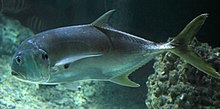Carangidae
| Carangidae Temporal range:
| |
|---|---|

| |
| Crevalle jack, Caranx hippos | |
| Scientific classification | |
| Domain: | Eukaryota |
| Kingdom: | Animalia |
| Phylum: | Chordata |
| Class: | Actinopterygii |
| Order: | Carangiformes |
| Suborder: | Carangoidei |
| Family: | Carangidae Rafinesque, 1815 |
| Subfamilies | |
|
See text | |
The Carangidae are a family of ray-finned fish that includes the jacks, pompanos, jack mackerels, runners, trevallies, and scads. It is the largest of the six families included within the order Carangiformes. Some authorities classify it as the only family within that order but molecular and anatomical studies indicate that there is a close relationship between this family and the five former Perciform families which make up the Carangiformes.[1]
They are marine fishes found in the Atlantic, Indian and Pacific Oceans. Most species are fast-swimming predatory fishes that hunt in the waters above reefs and in the open sea; some dig in the sea floor for invertebrates.[2]
The largest fish in the family, the greater amberjack, Seriola dumerili, grows up to 2 m in length; most fish in the family reach a maximum length of 25–100 cm.
The family contains many important commercial and game fish, notably the Pacific jack mackerel, Trachurus symmetricus, and the other jack mackerels in the genus Trachurus.[2]
Many genera have fairly extensive fossil records, particularly Caranx and Seriola, which extend into the early Paleogene (late Thanetian), and are known from whole and incomplete specimens, skeletal fragments, and otoliths. The several extinct genera include Archaeus, Pseudovomer, and Eastmanalepes.
Subfamilies and genera
[edit]
The family Carangidae is subdivided into the following subfamilies and genera:[1][3]
- Genus †Archaeus Agassiz, 1844 (formerly placed in invalid subfamily Archaeinae)[4]
- Genus †Belgocaranx Taverne, Simaeys & Steurbaut, 2006[5]
- Genus †Carangidarum [otolith]
- Genus †Matsyana Singh & Choudhary, 1972[6]
- Genus †Paratrachinotus Blot, 1969
- Genus †Trachicaranx Daniltshenko, 1968 (=Uylyaichthys Prokofiev, 2002)[7]
- Subfamily Trachinotinae Gill, 1861[8]
- Genus Lichia Cuvier, 1816
- Genus Trachinotus Lacepède, 1801
- Subfamily Scomberoidinae Gill, 1890[8]
- Genus Oligoplites Gill, 1863
- Genus Parona C. Berg, 1895
- Genus Scomberoides Lacepède, 1801
- Genus †Quasioligoplites Bannikov, 1995[9]
- Subfamily Naucratinae Bleeker, 1859[8]
- Genus Campogramma Regan, 1903
- Genus Elagatis F.D. Bennett, 1840
- Genus Naucrates Rafinesque, 1810
- Genus Seriola Bleeker, 1854
- Genus Seriolina Wakiya, 1924
- Subfamily Caranginae Rafinesque, 1815[8]
- Genus Alectis Rafinesque, 1815
- Genus Alepes Swainson, 1839
- Genus Atropus Oken, 1817
- Genus Atule D.S. Jordan & E.K. Jordan, 1922
- Genus Carangoides Bleeker, 1851
- Genus Caranx Lacepède, 1801
- Genus Chloroscombrus Girard, 1858
- Genus Decapterus Bleeker, 1851
- Genus Gnathodon Bleeker, 1850
- Genus Hemicaranx Bleeker, 1862
- Genus Megalaspis Bleeker, 1851
- Genus Pantolabus Whitley, 1931
- Genus Parastromateus Bleeker, 1864
- Genus Pseudocaranx Bleeker, 1863
- Genus Selar Bleeker, 1851
- Genus Selaroides Bleeker, 1851
- Genus Selene Lacepède, 1802
- Genus Trachurus Rafinesque, 1810
- Genus Ulua D.S. Jordan & Snyder, 1908
- Genus Uraspis Bleeker, 1855
- Genus †Eastmanalepes Bannikov, 1984
- Genus †Eothynnus Woodward, 1901
- Genus †Pseudovomer Sauvage, 1870
- Genus †Teratichthys Koenig, 1825
- †Vomeropsinae Bannikov, 1984[10]
- †Ceratoichthys Blot, 1969
- †Vomeropsis Heckel, 1854
See also
[edit]There are a great many fish called trevallies, most of which belong to the Carangidae. For articles on them, see All pages with titles containing Trevally.
References
[edit]- ^ a b J. S. Nelson; T. C. Grande; M. V. H. Wilson (2016). Fishes of the World (5th ed.). Wiley. pp. 380–387. ISBN 978-1-118-34233-6. Archived from the original on 2019-04-08. Retrieved 2019-11-17.
- ^ a b Froese, Rainer; Pauly, Daniel (eds.). "Family Carangidae". FishBase. August 2019 version.
- ^ Eschmeyer, William N.; Fricke, Ron & van der Laan, Richard (eds.). "Genera in the family Carangidae". Catalog of Fishes. California Academy of Sciences. Retrieved 17 November 2019.
- ^ Bannikov, A. F.; Erebakan, I. G. (2023-04-01). "A New Species of Horse Mackerel Fish of the Genus Archaeus (Carangidae, Percomorpha) from the Lower Oligocene of the North Caucasus". Paleontological Journal. 57 (2): 199–205. doi:10.1134/S0031030123020041. ISSN 1555-6174.
- ^ Taverne, Louis; Simaeys, Stefaan van; Steurbaut, Etienne (2006). "Belgocaranx luypaertsi gen. and sp. nov., a new skeleton-based Carangid Fish from the Boom Clay (Rupelian, Early Oligocene) at Kallo (N. Belgium)". Bulletin de l'Institut Royal des Sciences Naturelles de Belgique - Bulletin van het Koninklijk Belgisch Instituut voor Natuurwetenschappen. 76: 119–130.
- ^ Singh, S. N.; Choudhary, N. K. (1972). "A New Fossil Fish Genus From The Eocene Of Rajasthan, India" (PDF). Geophytology. 2 (2): 206–210.
- ^ Bannikov, Alexander (2009). Fossil Vertebrates of Russia and Adjacent Countries. Fossil Acanthopterygians Fishes (Teleostei, Acanthopterygii) (in Russian). GEOS, Moscow.
- ^ a b c d Richard van der Laan; William N. Eschmeyer & Ronald Fricke (2014). "Family-group names of Recent fishes". Zootaxa. 3882 (2): 001–230. doi:10.11646/zootaxa.3882.1.1. PMID 25543675.
- ^ Bannikov, Alexander (1995). "A NEW MIDDLE EOCENE GENUS OF CARANGID FISHES (PERCIFORMES) FROM THE NORTHERN CAUCASUS" (PDF). Paleontological Journal. 29 (2).
- ^ Bannikov, Alexander F. (1984). "The New Subfamily of Carangid Fishes". Studi e ricerche sui giacimenti terziari di Bolca. IV: 319–321.
